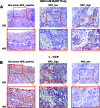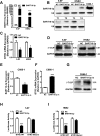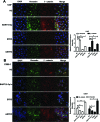EBV-miR-BART10-3p facilitates epithelial-mesenchymal transition and promotes metastasis of nasopharyngeal carcinoma by targeting BTRC
- PMID: 26497204
- PMCID: PMC4747187
- DOI: 10.18632/oncotarget.6155
EBV-miR-BART10-3p facilitates epithelial-mesenchymal transition and promotes metastasis of nasopharyngeal carcinoma by targeting BTRC
Abstract
Epstein-Barr virus (EBV) infection is closely associated with tumorigenesis and development of nasopharyngeal carcinoma (NPC), but the underlying molecular mechanisms remain poorly understood. It has been recently reported that EBV encodes 44 mature miRNAs, some of which were found to promote tumor development by targeting virus-infected host genes or self-viral genes. However, few targets of EBV encoded-miRNAs that are related to NPC development have been identified to date. In this study, we revealed that in NPC cells, EBV-miR-BART10-3p directly targets BTRC gene that encodes βTrCP (beta-transducin repeat containing E3 ubiquitin protein ligase). We found that EBV-miR-BART10-3p expression in clinical samples from a cohort of 106 NPC patients negatively correlated with BTRC expression levels. Over-expression of EBV-miR-BART10-3p and down-regulation of BTRC were associated with poor prognosis in NPC patients. EBV-miR-BART10-3p promoted the invasion and migration cabilities of NPC cells through the targeting of BTRC and regulation of the expression of the downstream substrates β-catenin and Snail. As a result, EBV-miR-BART10-3p facilitated epithelial-mesenchymal transition of NPC. Our study presents an unreported mechanism underlying EBV infection in NPC carcinogenesis, and provides a potential novel biomarker for NPC diagnosis, treatment and prognosis.
Keywords: BTRC; EBV-miR-BART10-3p; Epstein-Barr virus (EBV); epithelial-mesenchymal transition (EMT); nasopharyngeal carcinoma (NPC).
Conflict of interest statement
The authors declare that there are no conflicts of interest in this work.
Figures










References
-
- Xiong W, Zeng ZY, Xia JH, Xia K, Shen SR, Li XL, Hu DX, Tan C, Xiang JJ, Zhou J, Deng H, Fan SQ, Li WF, Wang R, Zhou M, Zhu SG, et al. A susceptibility locus at chromosome 3p21 linked to familial nasopharyngeal carcinoma. Cancer Res. 2004;64:1972–1974. - PubMed
-
- Zeng Z, Zhou Y, Zhang W, Li X, Xiong W, Liu H, Fan S, Qian J, Wang L, Li Z, Shen S, Li G. Family-based association analysis validates chromosome 3p21 as a putative nasopharyngeal carcinoma susceptibility locus. Genet Med. 2006;8:156–160. - PubMed
-
- Lo KW, To KF, Huang DP. Focus on nasopharyngeal carcinoma. Cancer Cell. 2004;5:423–428. - PubMed
-
- Zeng Z, Huang H, Zhang W, Xiang B, Zhou M, Zhou Y, Ma J, Yi M, Li X, Li X, Xiong W, Li G. Nasopharyngeal carcinoma: advances in genomics and molecular genetics. Sci China Life Sci. 2011;54:966–975. - PubMed
-
- Pagano JS. The Epstein-Barr virus and nasopharyngeal carcinoma. Cancer. 1994;74:2397–2398. - PubMed
Publication types
MeSH terms
Substances
LinkOut - more resources
Full Text Sources
Other Literature Sources
Research Materials
Miscellaneous

